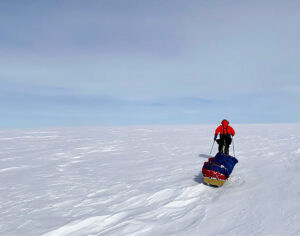Although I’ve done many expeditions to both the North and South Poles, both as an independent traveler and a guide, every fresh trip brings up new gear ideas. There are also old, tried-and-true standards that I have used for years. As I begin the South Pole season, let’s take a look at my gear. Today’s last installment in the series: solar chargers.
One note: Proper gear is just one aspect of polar travel. Developing skills, planning and logistics, understanding the polar environment, and knowing how to minimize risk are all equally important. If you would like to fast-track your development as a polar traveler, consider hiring an IPGA guide.
Solar chargers
There are a lot of solar chargers on the market but few are suitable for polar expeditions.
Sunlight needs to pass through more air mass in the polar regions and is therefore less efficient. With direct sunlight, solar chargers work adequately for about two months on either side of the summer solstice. The further you are from the solstice, and the equator, the greater the chance of underperformance. That’s why we use solar chargers on South Pole expeditions, which take place in summer. They don’t work well on North Pole expeditions, which are typically late winter-early spring.

This solar charger was almost ineffectual and we lost all power to our devices. Crossing a narrow lead while skiing to the North Pole from Russia. Photo: Eric Philips
Assuming you need to consistently charge or top-up a 20,000mAh power bank, you’ll need a minimum 21W solar charger to cater to the vagaries of your polar location. I have never needed anything more than the Anker Power Port 21W in Antarctica or across Greenland (May-June).
Often, the panels will even work inside the tent, which is super convenient. If you’re hungry for more, the Big Blue 3 28W is a good choice. They have two or three USB ports, will deliver a regulated charge to multiple devices under optimum conditions, and have charge interruption recovery. Be sure to use dummy USB plugs to keep snow out of any unused ports. My old iPhone 11 charged directly from my panel but I haven’t tried my 14 Pro yet. When in doubt, I use the power bank.
One of my pet peeves is over-engineering for the sake of having something look robust when it’s actually not. Solar chargers with mechanical hinges and hard exteriors fail miserably. In my experience, the best solution is a foldable charger with cells surrounded by polyester canvas. Nothing breakable. Heavy-duty eyelets are needed to keep it connected to your sled/tent.

One of my Anker Power Port 21W’s. One of the corners now has a gated clip to prevent loss.
You can damage a frigid power bank if you try to charge it, so warm its battery first. Keep your power bank topped up at every opportunity and never allow it to drop below 20%, as it may not recover.





